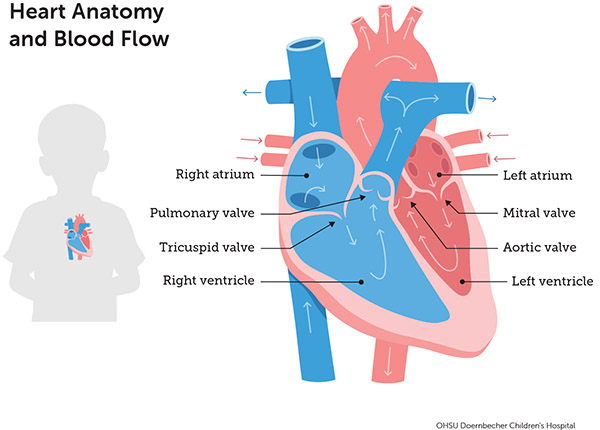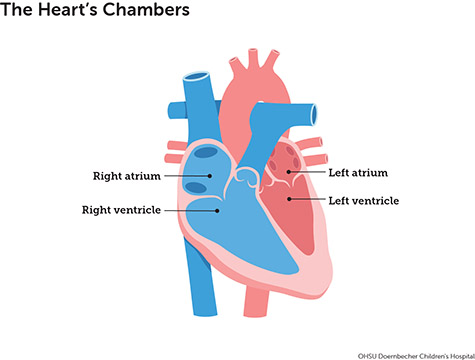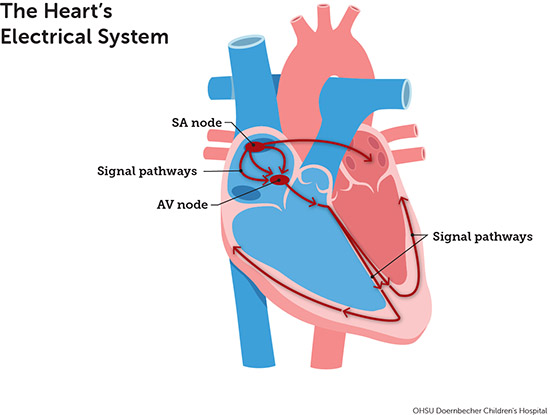Understanding Pediatric Heart Conditions

Learning more about your child’s heart condition can help make a potentially scary diagnosis less so. It’s important to know:
- It’s relatively common for a child to be born with a heart defect.
- Many pediatric heart conditions are not severe. Some need only monitoring.
- Thanks to new technologies and treatments, babies born with heart conditions are living longer, healthier lives.
What are children’s heart conditions?
Pediatric heart conditions may affect:
- The heart’s structure
- The heart’s electrical system, which controls the heartbeat
- The blood vessels that carry blood through the body
How the heart works
To understand heart conditions, it helps to understand some basics about how a heart works when it has a normal structure.
The heart muscle pumps blood through the body:
- The right side pumps oxygen-poor blood to the lungs, where it picks up oxygen.
- The left side pumps the oxygen-rich blood to the rest of the body to nourish organs and tissues.

Basic heart anatomy
The heart has four chambers:
- A right atrium
- A right ventricle
- A left atrium
- A left ventricle
Oxygen-poor blood (deoxygenated blood) enters the right atrium. From there, it passes to the right ventricle, which pumps it into the pulmonary artery and on to the lungs to take up oxygen.
Oxygen-rich blood returns from the lungs through the pulmonary veins. It passes through the left atrium and into the left ventricle, which pumps it into the aorta. The aorta, the body’s main artery, sends blood to the rest of the body.
After the blood circulates through the body, it returns to the right side of the heart to begin the cycle again.

The heart has four valves:
- The tricuspid valve
- The pulmonary valve
- The mitral valve
- The aortic valve
These valves open and tightly close to keep blood flowing smoothly and in the proper direction.

The heart has an electrical system:
The heart’s electrical system controls the heartbeat’s rate and rhythm, like a light being switched on and off. The heart’s conduction system sends electrical signals along a pathway through the heart, like wires in a house, to tell parts precisely when to contract. The process repeats for each heartbeat, dozens of times a minute.

How common are children’s heart conditions?
Congenital heart conditions are among the most common birth defects in the United States, affecting about one baby in every 100 births.
Outcomes
Milder conditions: About 95% of babies with mild or moderate heart conditions survive to adulthood.
More serious conditions: Thanks to better detection and surgery in the first year of life, the outlook for babies with critical congenital heart disease has improved. Nearly 80% of children with congenital heart conditions now reach adulthood.
What causes children’s heart conditions?
In most cases, the cause of a congenital heart defect is unknown. There may be several factors. Some conditions are related to genetic conditions that occur on their own or that are passed down in families. Other conditions are the result of a childhood illness such as rheumatic fever.
Screening for children’s heart conditions
Timely testing is often crucial to finding a heart issue before it becomes serious. Results can range from showing that a child’s heart works fine to showing that treatment is needed right away. Some tests can be done before your baby is born (prenatal screening).
Common tests include:
- Prenatal echocardiogram (an ultrasound of the fetal heart) to create clear images of a developing baby’s heart and other organs.
- Electrocardiogram to measure the heart’s electrical activity.
- Echocardiogram to track the heart’s structures and blood flow.
- Diagnostic heart catheterization to evaluate the heart and lungs.
- CT (computed tomography) scans to create high-definition images of the heart, blood vessels and lungs.
- Cardiac MRI (magnetic resonance imaging) to show clear, detailed images of the moving heart.
- Genetic testing to identify DNA changes that may cause heart conditions.
Learn more on our Diagnostic Tests page.
If a screening test shows signs of a heart condition or defect, please share any questions or concerns with your Doernbecher providers. They are in the best position to assess your child and work with you to develop a treatment plan.

Types of children’s heart conditions
Children’s heart conditions and symptoms vary widely, from heart murmurs that need no treatment to complex valve or heart rhythm disorders. Some children may have more than one heart problem. Heart conditions can be congenital (present at birth) or acquired (developing later in life).
Congenital heart defects affect about 40,000 babies a year in the U.S., or about 1% of live births. These defects develop in the early months of pregnancy, when the structures of the heart form.
They include:
- Holes in the heart, when walls between heart chambers don’t develop properly. These holes can lead to heart failure, high blood pressure in the lungs and other issues.
- Valve anomalies, either leaks or narrowing, that limit the heart’s ability to pump blood effectively.
- Conditions that affect the veins and arteries that carry blood through the body.
Learn more about congenital heart defects.
Acquired heart conditions develop after a child is born. They are less common than congenital heart defects.
They can be caused by childhood illnesses or chronic diseases that affect other parts of the body. They also may develop after treatment such as chemotherapy, or after surgery to correct a congenital heart defect.
Types include:
- Kawasaki disease, which causes inflammation and other problems with the coronary arteries — the blood vessels that deliver oxygen-rich blood to the heart.
- Rheumatic heart disease, a rare condition that happens when rheumatic fever damages heart valves.
- Myocarditis, pericarditis and endocarditis, types of heart inflammation.
- Cardiomyopathy, a rare condition in children in which the heart’s muscle becomes stiff, thick or enlarged.
Learn more about acquired heart conditions.
Arrhythmias are any change to a heartbeat’s normal rate or rhythm. An irregular heart rhythm can mean that a child’s heart beats too quickly or too slowly, or that it skips beats or has extra beats.
Most arrhythmias are harmless, but some keep the heart from pumping effectively.
The main types of arrhythmia are:
- Fast heart rhythms (tachycardia). Most of the time, tachycardia is a normal response to stress, exercise or fever. Less often, it’s related to a heart condition and needs treatment.
- Slow heart rhythms (bradycardia). A slow heart rate is rare in children but may require treatment.
Learn more about arrhythmias.
Certain genetic conditions can affect a child’s heart and other organs. They can be linked, for example, to arrhythmias, congenital heart defects or conditions that affect the heart muscle.
While rare, these conditions can become serious if not treated. Our fetal heart care experts can help your family understand options before birth and plan for care.
Learn more about genetic syndromes that can affect the heart.
Pulmonary hypertension happens when blood vessels in the lungs stiffen or narrow. This causes high blood pressure in the lung arteries, which forces the right side of the heart to work harder. It may be caused by other conditions or arise on its own. Pulmonary hypertension can occur shortly after birth, especially in babies born prematurely, or later in life.
Learn about our pulmonary hypertension program.
Learn more
Go to our Resources for Children and Families page to find:
- Links to more information about how the heart works.
- Links to more information about children’s heart conditions.
For families
Call 503-346-0640 to:
- Request an appointment.
- Seek a second opinion.
- Ask questions.
Locations
Parking is free for patients and their visitors.
Doernbecher Children’s Hospital
700 S.W. Campus Drive
Portland, OR 97239
Map and directions
Find other locations across Oregon and in southwest Washington.
Refer a patient
- Refer your patient to OHSU Doernbecher.
- Call 503-346-0644 to seek provider-to-provider advice.
‘The zipper club’
See how an eye-catching sneaker brought Doernbecher heart patient Finnigan Mooney and an ESPN reporter together. Both are in the “zipper club,” reporter Wayne Drehs writes, for patients with open-heart-surgery scars.